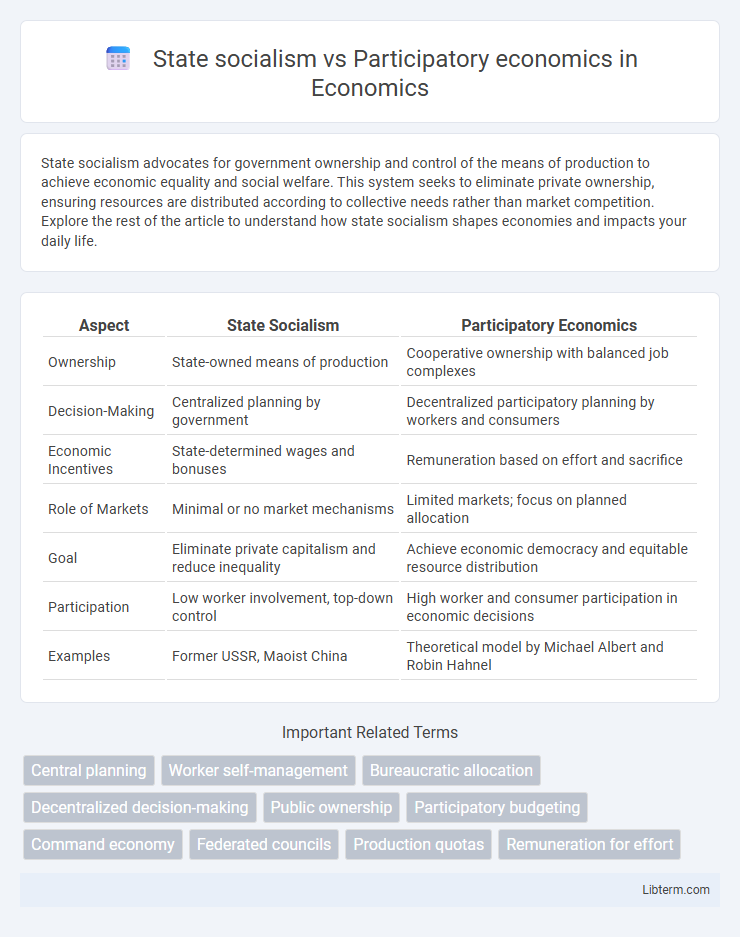State socialism advocates for government ownership and control of the means of production to achieve economic equality and social welfare. This system seeks to eliminate private ownership, ensuring resources are distributed according to collective needs rather than market competition. Explore the rest of the article to understand how state socialism shapes economies and impacts your daily life.
Table of Comparison
| Aspect | State Socialism | Participatory Economics |
|---|---|---|
| Ownership | State-owned means of production | Cooperative ownership with balanced job complexes |
| Decision-Making | Centralized planning by government | Decentralized participatory planning by workers and consumers |
| Economic Incentives | State-determined wages and bonuses | Remuneration based on effort and sacrifice |
| Role of Markets | Minimal or no market mechanisms | Limited markets; focus on planned allocation |
| Goal | Eliminate private capitalism and reduce inequality | Achieve economic democracy and equitable resource distribution |
| Participation | Low worker involvement, top-down control | High worker and consumer participation in economic decisions |
| Examples | Former USSR, Maoist China | Theoretical model by Michael Albert and Robin Hahnel |
Understanding State Socialism: Core Principles
State socialism centers on government ownership and control of the means of production, aiming to achieve economic equality through centralized planning and redistribution. Key principles include collective ownership of resources, state-directed economic activity, and the elimination of private property to reduce class disparities. This system emphasizes top-down management to ensure equitable allocation and social welfare, contrasting with decentralized economic decision-making.
Defining Participatory Economics: Key Concepts
Participatory economics, or parecon, emphasizes workplace democracy, balanced job complexes, and remuneration based on effort and sacrifice, aiming to replace hierarchical state socialism structures. It advocates decentralized planning through participatory decision-making councils rather than centralized state control, promoting equitable resource allocation and individual empowerment. This system challenges traditional state socialism by prioritizing collective self-management and social equity over state ownership and top-down distribution.
Historical Contexts: Origins and Development
State socialism emerged in the 19th and 20th centuries as a response to industrial capitalism, emphasizing centralized control of the means of production by the state to achieve economic equality. Participatory economics, developed in the late 20th century by economists Michael Albert and Robin Hahnel, arose as a critique of both state socialism and capitalism, advocating decentralized decision-making through participatory planning and balanced job complexes. Historical developments of state socialism include the Soviet Union and Eastern Bloc models, while participatory economics remains influential in contemporary movements for democratic economic reform.
Economic Planning: Centralization vs. Decentralization
State socialism relies on centralized economic planning, where a central authority dictates resource allocation and production decisions to achieve social ownership and equitable distribution. Participatory economics emphasizes decentralized planning, enabling workers and consumers to collaboratively negotiate and self-manage production schedules based on democratic decision-making processes. This decentralized approach aims to increase efficiency and flexibility by incorporating local knowledge and preferences into economic planning, contrasting with the top-down directives typical of state socialism.
Decision-Making Structures: Hierarchies vs. Direct Participation
State socialism typically relies on hierarchical decision-making structures, where centralized authorities control economic planning and resource allocation, enabling large-scale coordination but often limiting individual input. Participatory economics emphasizes decentralized, democratic decision-making through councils and assemblies, allowing workers and consumers to directly influence production and consumption choices, fostering inclusivity and responsiveness. The contrast lies in top-down control versus bottom-up participation, shaping efficiency, equity, and empowerment differently in each system.
Ownership Models: State-Controlled vs. Collective Ownership
State socialism centralizes ownership under government control, where the state manages and distributes resources on behalf of the public, aiming to eliminate private property and market competition. Participatory economics advocates for collective ownership through worker and consumer councils, emphasizing decentralized decision-making and equitable distribution of power and resources among participants. The key distinction lies in state-controlled ownership concentrating authority within a bureaucratic apparatus, whereas participatory economics fosters democratic, grassroots management of productive assets.
Addressing Inequality: Distribution Mechanisms
State socialism uses centralized planning and state ownership to redistribute wealth through mechanisms like progressive taxation and government welfare programs, aiming to reduce inequality by controlling production and income allocation. Participatory economics replaces top-down control with decentralized, democratic decision-making in workers' and consumers' councils, emphasizing equitable resource allocation and remuneration based on effort and sacrifice rather than capital ownership. Both systems seek to address inequality but differ fundamentally in distribution mechanisms: state socialism relies on hierarchical redistribution, while participatory economics promotes direct economic democracy for fairness.
Incentives and Motivation: Work, Innovation, and Social Goals
State socialism often relies on centralized planning and state ownership to align work incentives with social goals, but it may face challenges in fostering individual innovation due to rigid hierarchies and uniform motivation structures. Participatory economics promotes decentralized decision-making and balanced job complexes, enhancing intrinsic motivation by empowering workers and aligning personal satisfaction with community well-being, which can drive innovation and equitable productivity. Both systems aim to prioritize social objectives over profit, yet participatory economics emphasizes continuous feedback and democratic participation to sustain long-term motivation and adaptive innovation.
Critiques and Challenges: Practical Limitations
State socialism faces critiques regarding bureaucratic inefficiencies and centralized decision-making that often lead to resource misallocation and stifled innovation. Participatory economics challenges include difficulties in scaling democratic planning processes and potential burdens on individual time and expertise for effective participation. Both systems confront practical limitations in balancing equitable resource distribution with economic efficiency and responsiveness to complex market dynamics.
Pathways Forward: Hybrid Models and Future Prospects
State socialism and participatory economics offer distinct approaches to economic organization, with hybrid models increasingly explored to combine centralized planning efficiency and grassroots democratic control. Emerging frameworks integrate state-driven resource allocation with participatory budgeting and worker self-management, fostering responsiveness and equity in socio-economic systems. Future prospects emphasize leveraging digital platforms and decentralized technologies to enhance transparency, inclusion, and adaptive governance within these hybrid economic models.
State socialism Infographic

 libterm.com
libterm.com